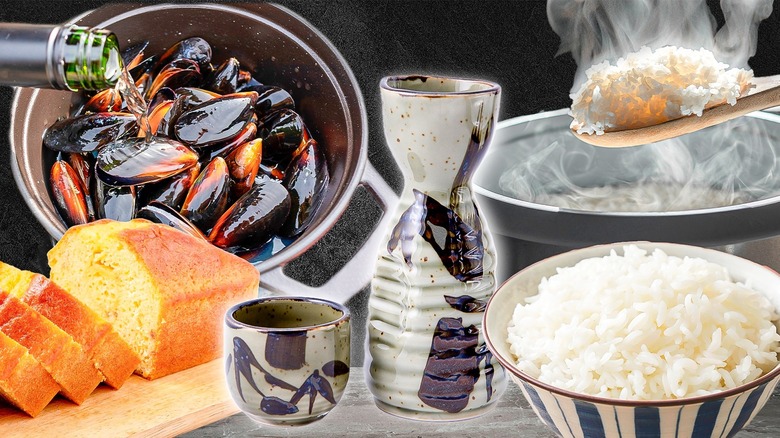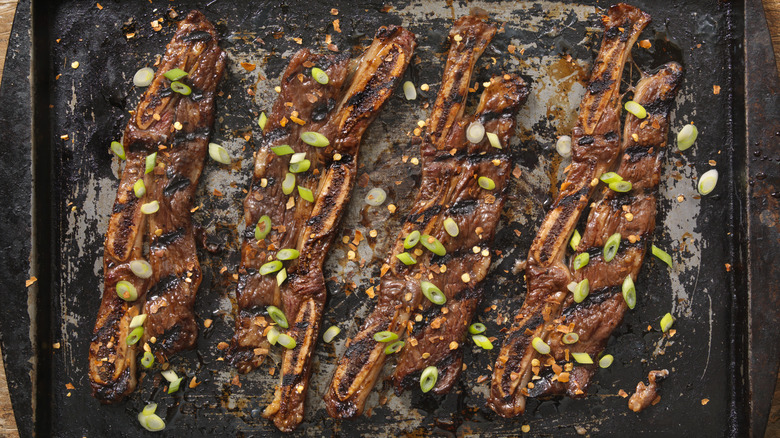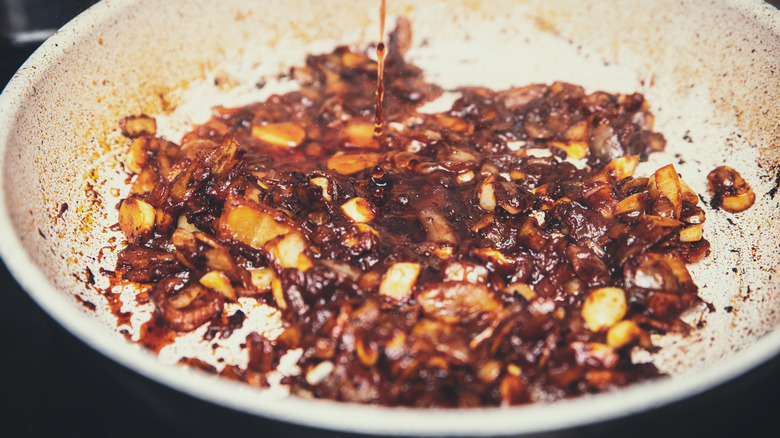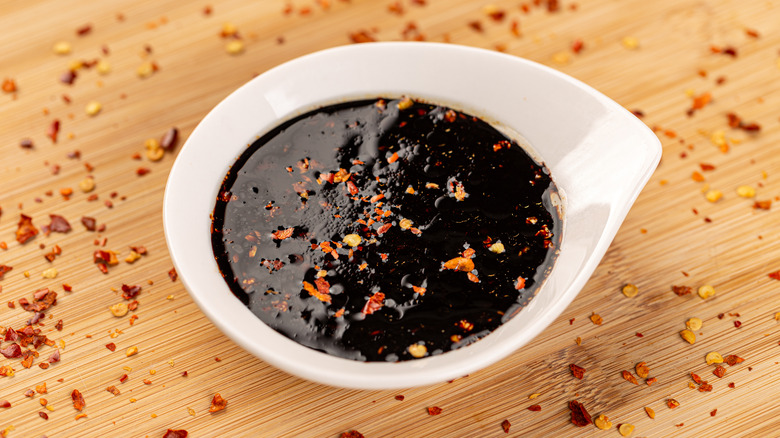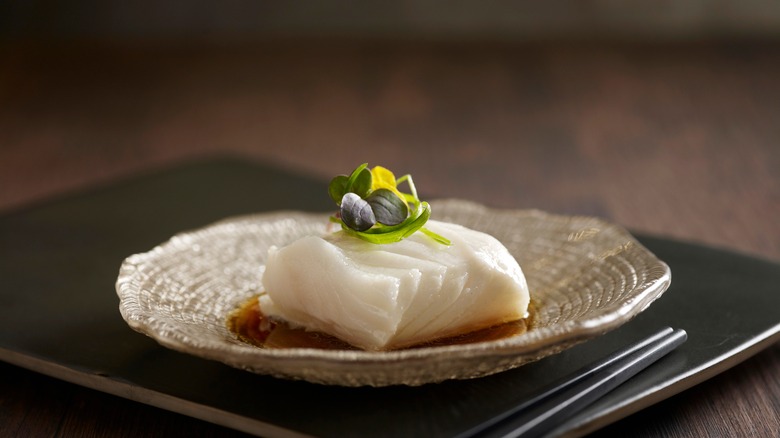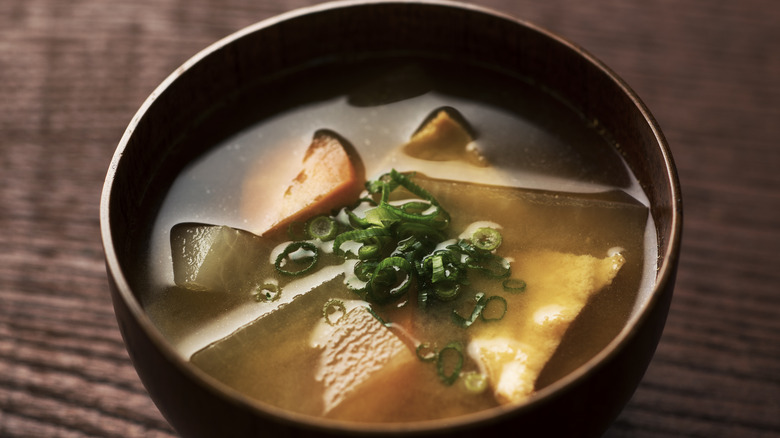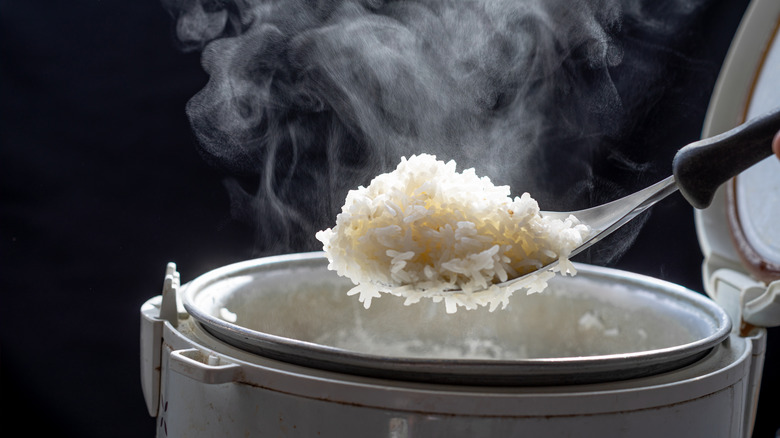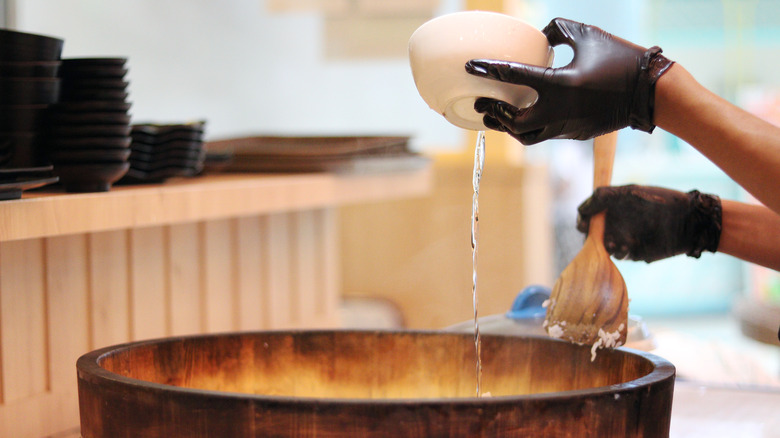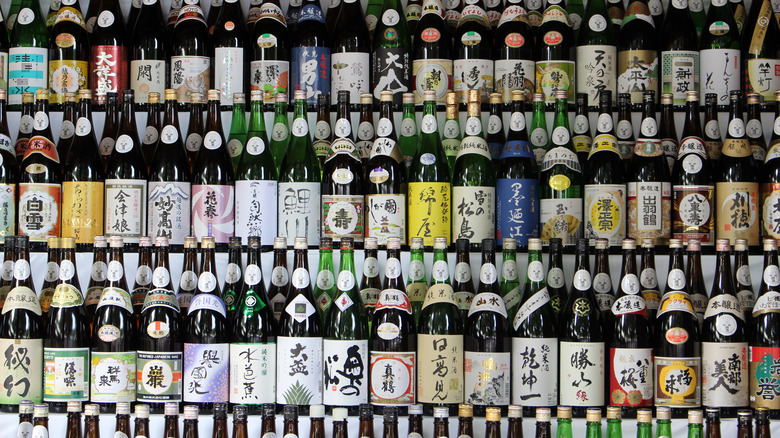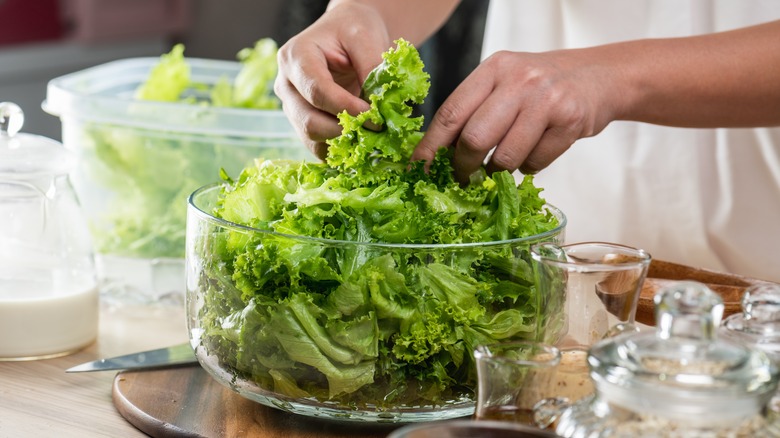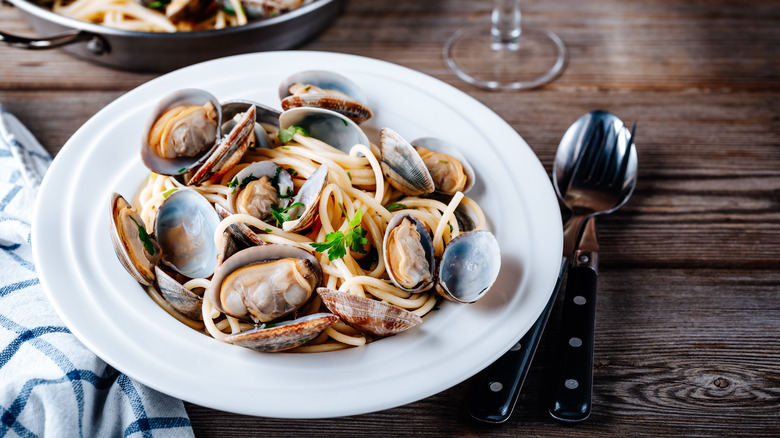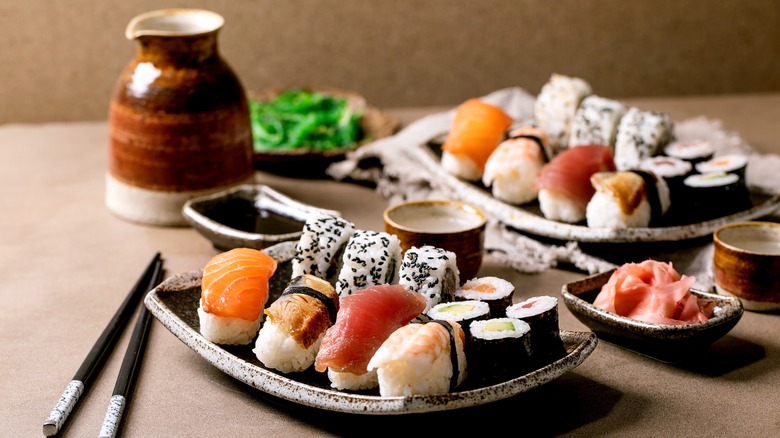13 Tips You Should Know When Cooking With Sake
Although it's just starting to make its way into mainstream American bars and restaurants, sake has been around for millennia. Made from fermented, polished rice, this alcoholic beverage comes in a huge range of different varieties, each with a unique flavor profile. In Japan, there is even a divine feminine myth behind the invention of sake that explains that it was created when a god spit a grain of rice into a jar.
Sake is a taste experience on its own, but it can also be used as an ingredient in the kitchen that can lend a complex flavor to dishes. You can use sake in much the same way you use wine in cooking, and although it provides a similar function in terms of deglazing pots and adding bright flavors, it brings its own taste to the table.
If you're looking for an easy, effective way to add a sophisticated edge to your cooking, look no further than sake. Read on to find out about all the different ways that you can incorporate sake into your culinary pursuits.
Chose the right sake
Not all sake was created equal. The flavors of sake are as varied as those of wine; sake can range from dry to sweet, from acidic to smooth, and everything in between. And your ability to choose the right sake for your meal is just as important as how you use it. Bottles labeled "cooking sake," for instance, are made from lower-quality rice and often contain additives like amino acids, sugar, and salt, which can drastically alter the outcome of your dish. Cooking sake is cheaper than drinking sake, and the additives can actually boost the umami flavor of a dish, but you've got to be careful when you're using it because it can easily make your food too salty and compete with other more subtle flavors.
But if you're making a dish that will heavily feature the taste of sake, you'll want to go with a slightly higher-quality bottle. Don't spend tons of money on a bottle of sake that you're going to use for cooking, but there are plenty of mid-range bottles that are perfectly enjoyable to drink and can also lend dishes a crisp, mellow rice flavor. This is especially important when you're using sake to make desserts.
Make a sake-based marinade
Marinating your meat before you cook is a tried and true way to add flavor to a dish. A marinade should always contain an acidic component, which is often vinegar or lemon juice, but using sake to marinate your meat provides an acid while lending the meat some great umami flavor. The acidic sake works to break down proteins on the outside of the meat, which allows the taste of the marinade to enter the meat so that it is super flavorful once you cook it. It also tenderizes meat, which can help make tough cuts of meat juicier and easier to eat.
Sake is wonderful in a marinade with other Japanese ingredients like mirin, another fermented rice product with a sweet, umami flavor. You can use sake to marinate seafood, chicken, meat, or even tofu. Using sake in a marinade infuses food with a smooth, balanced umami taste that is perfect for a whole host of recipes, from teriyaki to kalbi (Korean marinated short ribs).
Deglaze your pan with sake
While wine is perhaps the most common liquid used to deglaze a pan, sake is a great option, especially if you're looking to give dishes a subtle, authentic Asian flavor. Deglazing your pan might sound like an intimidating task reserved for culinary school graduates, but it simply refers to using a liquid to loosen the caramelized bits from the bottom of the pan so that their flavors can get incorporated into your dish. You can use just about any liquid to deglaze a pan, but sake is particularly well suited for dishes that could use a slightly acidic tang and a mellow umami flavor.
After you cook meat or vegetables, take them out of the pan and pour a bit of sake in it. Using a spatula, scrape the brown bits on the bottom of the pan until they loosen up and incorporate into the sake. The flavor of sake pairs remarkably well with the deep umami taste of caramelized taste of meat and vegetables, and you can mix the resulting liquid with other elements like soy sauce and mirin to make a sauce so good that you'll feel like you're eating at an izakaya.
Put sake in your sauces
Teriyaki sauce seems complicated, right? With its complex umami flavors and slightly sweet, sticky consistency, it's easy to think that it'd be hard to perfect this recipe. But the truth is that you can make traditional Japanese teriyaki sauce with just three ingredients: sugar, soy sauce, and, of course, sake. While the sugar and soy sauce are responsible for the sweet, funky taste of teriyaki, the sake balances out those bold flavors with a smooth, fruity complexity.
And there's way more to cooking with sake than just teriyaki chicken. Sake is commonly added to tons of other sauces like ponzu, okonomiyaki, and yakisoba, to name a few. It's also great for making dipping sauces like Japanese tare sauce, which is made by cooking down mirin, soy sauce, garlic, shallots, sugar, ginger, vinegar, and sake into a thick sauce that you can pour on just about anything for a burst of Japanese umami flavor.
Steam with sake
If you've ever steamed food, you know that it's a great way to cut down on the fat content of a dish and keep it juicy and moist. There are plenty of ways to add more flavor to steamed food, like using broth or stock instead of water, but you can also use sake to make your meal a little bit more complex and sophisticated. As the food cooks, the steam from the sake carries its aroma and taste, infusing it with the smooth sake flavor.
So what can you steam with sake? White fish is a great candidate for sake steaming because it has a mild flavor, so it easily absorbs the flavors of the sake, and it has a delicate texture, which makes it perfect to steam because it's less likely to fall apart the way it would in a frying pan. And throw some vegetables in the mix for a more healthy, colorful plate. Sake steamed clams are another super easy way to incorporate sake into your culinary repertoire. You can mix your sake with some ginger, put it in a pot with whatever type of clam you have on hand, and have a seafood feast with a subtle, sophisticated flavor palate.
Add a splash to soups and stews
From classics like miso soup to all the different types of ramen that have taken the restaurant scene by storm recently, Japanese cuisine has a lot to offer regarding soups and broths. What you might not know is that the secret ingredient in many of these broths is sake. Japanese soups and broth can range from thick and heavy to light and fresh, but most have an umami element that makes them hit the mark when you slurp them up. Sake is a perfect way to brighten up a soup because it has a flavor that balances freshness and acidity with a slightly umami undertone that comes from the rice with which it is made.
You can add sake to a whole range of different broths when you're making soup. Whether your base is chicken broth, fish broth, water, or dashi (a traditional Japanese broth made primarily of seaweed and dried fish), adding a splash of sake is certain to add a whole new flavor dimension without overpowering.
Make rice with sake
Versatile, nutritious, and affordable, rice is one of the most consumed foods in the world, and although a steaming hot bowl of rice is perfectly delicious in its own right, there's always room for improvement. And if you're looking to add more flavor to white rice, sake is just the ingredient for the job.
Whether you're making your rice on a stove or in a cooker, you can replace a portion of the water that you would normally use with sake to give it a subtle acidic bite, and a unique, glossy appearance. Sake-flavored rice can be a great accompaniment to more delicate flavors like steamed fish and vegetables or stand up to bolder ones in dishes like Japanese curry. And you don't have to stop with sake. Adding other seasonings like mirin, sugar, and dashi can also turn a regular bowl of rice into an umami party for your taste buds.
Control alcohol evaporation
Cooking with alcohol can seem intimidating. You certainly don't want your finished product to be a big boozy mess, but with a bit of scientific knowledge, you can get the most out of cooking with sake to maximize the flavor and control the amount of sharper, more astringent-tasting alcohol. When you use sake in a dish, you can't just add a big splash right at the end; you need to give it enough cooking time for the alcohol to evaporate so that you're left with the delicious, concentrated sake flavor.
Sake typically contains about 15 percent alcohol, but because alcohol has a relatively low boiling point, most of that evaporates during the cooking process if done right. Although the amount of alcohol that boils off depends on the intensity of heat and surface area that you're cooking with; generally about 40 percent of the alcohol remains after 15 minutes of cooking, about 25 percent after an hour, and to get rid of the alcohol completely, you need to cook it for about 3 hours. And while you don't want your meal to taste like a cocktail, a touch of sharp alcoholic taste can be a great way to enhance the flavor and aroma of a dish.
Bake with sake
Pastries and sweet treats may not be the first menu items that come to mind when you think about cooking with sake. But there is a long-standing tradition of infusing alcohol into cakes, frostings, creams, and other confections, and sake is a great way to add a unique complexity to a run-of-the-mill dessert.
Infusing cakes like pound cake with sake syrup is a great way to satisfy your sweet tooth with a sophisticated, unique flavor profile. But if you're using sake to soak your cake, you want to be mindful of the type of sake you're buying, and it's worth springing for a slightly higher quality bottle since the sake flavor will end up being a major component of the dish. You can also use sake in puddings, mousses, and compotes. In fact, the world's most expensive ice cream contains (among many other unique ingredients) sake lees, a sauce made with sake, mirin, sugar, and salt.
Keep your sake fresh
Like wine, the color and flavor of sake change over time. You want to be sure to store it correctly so that you can keep on using it for drinking and cooking for as long as possible. An unopened bottle of sake can be kept at room temperature, ideally in a dark place, because exposure to light can cause the molecules in the sake to break down more quickly. Once you open a bottle of sake, you want to keep it in the refrigerator to maximize its shelf life, and it generally retains its quality for about a week.
If you have an older bottle of sake that's been sitting around for a while and it doesn't taste quite as delicious as it did when you first popped it open, you can still use it to cook with. But if the sake has turned a strange color or emits a strong, rancid odor, it's best to throw it away and start with a new bottle. Also, sake is one of the alcohols you never want to put in the freezer because as the water in it expands into ice, the bottle can burst open.
Use it in salad dressing
The age of the boring salad is over. With so many different combinations available for fresh, crisp produce and zingy ingredients to use in salad dressings, there's no need to feel like eating salad is a chore. Sake is just a bit sweet, with a fermented tang that stands up to the natural bitterness in salad greens and provides a clean, refreshing finish.
You can make a classic Japanese ponzu sauce, which is made with soy sauce, dried fish flakes, sake, mirin, and citrus for a tart dressing that packs a huge amount of flavor. You can also use sake to balance out the taste and acidity of a vinaigrette. Since there are so many different types of sake available, you want to choose one that suits your salad. Aged sake has a deeper umami flavor and stronger aroma that can add depth to lighter lettuce, while the clean, light taste of Ginjo sake can provide a nice contrast to slightly more bitter salad ingredients.
Don't be afraid to experiment
Although sake is most commonly used in Japanese cooking, it's more versatile than you may think. You can use sake almost anywhere you use wine for cooking, and you may be surprised with the fun flavor combinations you can come up with when you use it in service of culinary creativity.
You can give classic recipes like linguine and clams, traditionally made with white wine, a subtle, unexpected umami undertone by replacing the traditionally used white wine with sake. Gyudon, a beef rice bowl common at Japanese restaurants, is often cooked with sake, and you can use the same time-tested combination to add a splash of sake to your hamburger meat for a unique flavor experience. And the fun doesn't stop in the kitchen. According to MarthStewart.com, sake has properties that make it useful as a beauty product, locking in moisture and helping to correct hyperpigmentation.
Pair sake with different foods
Sake doesn't have to be an ingredient in a dish to help you enjoy it. Having a certain type of sake alongside a gourmet meal can open up your palate and enhance your perception of flavors and textures in your food. Just like with wine, certain sakes pair well with certain types of food.
Interestingly, sake isn't usually paired with sushi in Japan because sushi and sake are both rice-based, which would be too much of a single flavor. When it comes to choosing whether to drink sake with a meal, you can ask yourself if the dish in question would go well with a bowl of rice. If the answer is yes, it will likely go well with a glass of sake. And there are so many different types of sakes to suit all kinds of food. Lighter foods call for an equally light sake, like a Ginjo, that doesn't eclipse the dish's flavor, while bolder flavors are best enjoyed with full-bodied varieties like Junmai.
